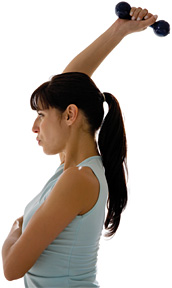Additionally, falling down is not necessarily a natural part of the aging process. Just look at children, who generally fall down much more frequently than adults, yet are able to withstand those falls and/or recover much more quickly.
It is the strength of the bones that determines the extent of damage (or lack thereof) when a fall does occur. Most falls can be prevented, yet they typically are more dangerous in the elderly population. For this reason, an important aspect of preventing bone fractures is to improve home safety and reduce accidents, in addition to improving bone density and strength.
How to Maximize Bone Health
The good news is that it is never too late to improve bone health. With daily exercise, good nutrition and other easy strategies, people of all ages can strengthen and maintain strong bones, resulting in longer, healthier lives. As early as childhood, you can plant the seeds of good bone health and continue to do so throughout life. Here are a few recommendations on how to keep your bones strong for a lifetime.
Exercise Regularly; Especially the Weight-Bearing Variety
 The first and most important way to build strong, healthy bones is to participate in weight-bearing exercise on a regular basis. In the past few decades, mounting evidence suggests that most people do not participate in enough physical exercise to support strong skeletal growth. A research review published in Sports Health emphasizes that weight-bearing exercises, especially those that include higher levels of strain such as running or jumping, can be effective in enhancing bone health and preventing future diseases and injury.
The first and most important way to build strong, healthy bones is to participate in weight-bearing exercise on a regular basis. In the past few decades, mounting evidence suggests that most people do not participate in enough physical exercise to support strong skeletal growth. A research review published in Sports Health emphasizes that weight-bearing exercises, especially those that include higher levels of strain such as running or jumping, can be effective in enhancing bone health and preventing future diseases and injury.
"There are many facets related to maintaining bone health, including genetic, intrinsic and environmental factors, but physical activity is by far one of the strongest means to develop and maintain healthy bone mass," explains Ron Zernicke, PhD, DSc, director of the Bone and Joint Injury Prevention and Rehabilitation Center at the University of Michigan, as quoted in Dr. Carmona's 2004 Report on Bone Health and Osteoporosis. "Because a high number of older women experience osteoporosis, postmenopausal women may receive the most benefits from improving bone mineral density (BMD) through weight-bearing exercise. Regardless of age, weight-bearing exercises are extremely beneficial."
While most exercises will help increase bone density, some are more beneficial than others. For instance, exercises that put a larger strain on the body (gymnastics, dance and power sports such as weight-lifting), exercises that involve a higher strain rate (e.g., jumping activities), and those that have a higher strain frequency (e.g., running) appear to increase bone density in particularly effective fashion. Research also notes that the benefits of exercise on bone health can be achieved with less time-consuming programs such as 12 minutes per session, three days a week. In the end, weight-bearing exercise, even when performed for 15-20 minutes per day, can strengthen the skeleton significantly.
Physical skeletal resistance is essential for elevated bone mass. While calcium is known for its positive effects on bone (see nutrition section below), it's important to recognize that regardless of the amount of calcium ingested, unless there is a physical need for the bones to get stronger from a stress demand, supplementation is almost useless.
The amount of calcium circulating in the blood is controlled by the parathyroid glands, small glands in the neck. Circulating blood calcium is removed and delivered to skeletal bones based on need (i.e., physical stress), causing the bone to adapt under mechanical force. The specific mechanism that increases bone density is known as the piezoelectric effect. In technical terms, bone-building cells called osteoblasts are attracted by electrical dipoles produced by the piezoelectric effect from stress on the bone or outside electrical stimuli, which, in turn, deposits minerals (primarily calcium) on the stressed side of the bone. Therefore, exercise stimulates bone cells to use calcium and increase the density of the stressed bone.

